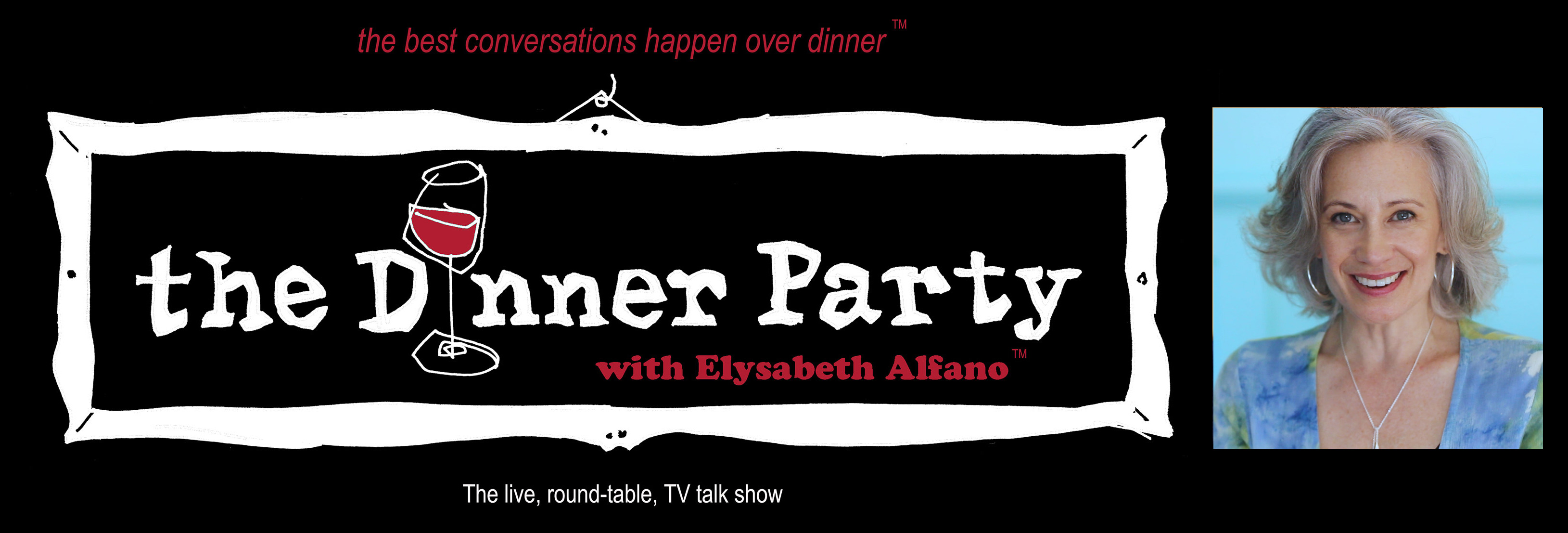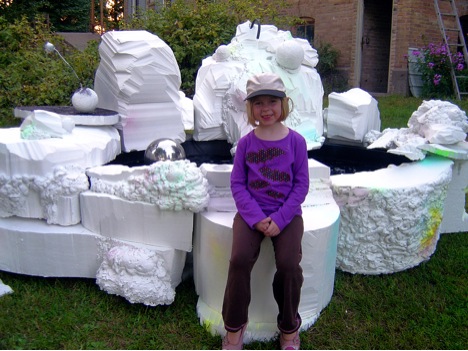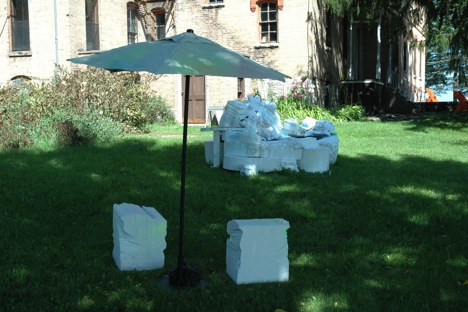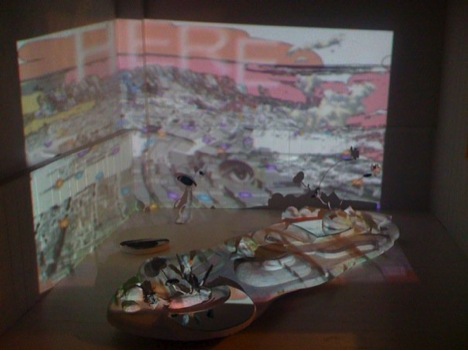Art & Artists by John Coyle Steinbrunner
September 15th, 2010Heavens on Earth: Sabina Ott at The Poor Farm
I’m not sure where to begin. There’s Sabina Ott, there’s Sabina Ott’s sculpture at Poor Farm, there’s Poor Farm, there’s Michelle Grabner, the founder of Poor Farm and at some point I’m going to mention Donald Judd, Wisconsin’s agrarian destitute and the Bible. And I write it like this because I think that’s the only way to write about Sabina’s work: slant-wise, in medias res, a restless drumming of fingers. You don’t look at Ott’s work, you get ensnared by it and pick your way out of the web.
So let’s spin the web. Back in the day Sabina Ott was my professor at Washington University in St. Louis. The Internet had just got pictures. I had an unfortunate wardrobe. She was the wild child of our four profs, throwing us ideas not so much off the wall as off the map of the territory of the wall. It was a very conceptual time; we were hopelessly Midwestern. It was a good mix.
Heaven’s on Earth: Ott’s Pleasure examines our assumptions about nature
Fast forward 12 years to a reunion in Chicago over at Russian Tea Time across from the Art Institute. Silver-haired now, but as spritely as ever, Sabina Ott is a professor of fine arts at Columbia. We order the vareniky, the piroshki, the latkes. (In a fit of responsibility I decline the vodka flight.) Sabina’s curiosity is as expansive as the meal; she peppers me with questions. My answers spark anecdotes on students, teaching, art making. I remember how nice it is to have that kind of high-level art discussion … and her throwing arm is as good as ever. (I’m a big nickel-word fan but she unseated me, breezily tossing “rhizomatic” into a story about grad school. I nod and fork a latke, sweating slightly.) The word was apropos: we were discussing “Pleasure for the Poor,” Ott’s new sculpture at Poor Farm.
Formerly an indentured working farm for Wisconsin’s poor located in Manawa, a four-hour drive from Chicago and due west of Green Bay, the Poor Farm has become a rural venue for art projects and residencies run by Michelle Grabner and Brad Killam of Oak Park’s The Suburban. Ott’s seemingly fragile “Pleasure for the Poor” is the venue’s latest installation. I remember Sabina’s work of years ago as a densely layered palimpsest of oil and encaustic on panels wrestling with the ghost of Duchamp and other pop specters. “Pleasure” is somehow more and less than those – more in that it is bigger and bolder, brash, brassy and lush; less because it’s simpler, stripped down, yet direct and lyrical.
The materials list reads like an inventory of Michael’s: styrofoam, plastic, pump, water, glitter, Latex, spray paint and steel. “Pleasure for the Poor” is a massive, sculpted-styrofoam artificial pond sprayed, glittered and garnished with a floating chrome steel ball. It is ugly-beautiful. It makes me think of Exodus – the Israelites following a self-referential cloud come down from the sky. It’s the stuffing of Anish Kapoor’s “Cloud Gate,” splayed inside out. It’s an expansive and expanding landmark on a Midwestern horizon. It is influenced by Donald Judd? Sort of.
Michelle Grabner’s daughter, Ceal, with “Pleasure for the Poor”
“I used to love Donald Judd,” exclaims Ott, taking more tea. “When I was in school, I read everything I could on minimalism.” Judd, associated with the minimalist sculpture of the ‘60s and ‘70s, believed that sculptural objects should refer only to themselves as pure form. It makes sense that Sabina would respond to that—she works the same way, just from the opposite direction. Instead of pure form, she starts with everything and pares it back. Editing, editing, editing. She’s a tractor beam in the deep space of popular culture, attracting flotsam and compressing it into an aggregate core that becomes, by virtue of its referential weight, something else. Signifiers refer to the outside world, become confused and start referring to each other. It gets gravity. In physics, the orbit of the moon is described as an object eternally falling toward Earth. Viewing “Pleasure” is to stand on the event horizon and feel that pull of an ever-collapsing system. What is distilled from that compression, and what I think singles out Sabina Ott, is the core pleasure of making and viewing art.
“Every material has a practical application that is rendered impractical and improbable,” reads Ott’s artist statement. “By engaging in an almost kitsch aesthetic, the hierarchy implied by good taste is challenged and replaced by unfettered excess as an expression of joy.”
Minimalism’s austerity of form and Judd’s obsession with the autonomy of the object become under Ott’s hand an full-throated howl of pleasure. But it’s still about objects. It’s not a reaction to austerity, it’s an embrace of it, an evolution, a rejoinder. And with “Pleasure” she’s focussed that tractor beam on how we perceive and appreciate the natural world.
“[‘Pleasure for the Poor’] is so elemental,” remarks Michelle Grabner. “How she plays with light—spray-painting the spectrum like light were being refracted. She plays with those tropes, asking us questions about why we value natural forms, questioning those value judgments with these unnatural things. It has fake light and fake forms and real light and real forms. It’s not of nature but it’s without decay – timeless – a degree of abstraction in the context of a farm.”
But is it weedwacker proof?: Ott’s “Pleasure” encorages lingering
Curiosity begs questions; questions beget answers; answers propose new questions. All this swells to a chorus of ways to perceive and refutations of the perceptions. And I think there’s something about the Midwest that gets Sabina’s blood up. Her work from America’s breadbasket has a Puckish glee to it. A second, indoor styrofoam installation goes a step further with the addition of a video projection.
“The inside piece is an inverse,” notes Grabner. “Ott’s consistent vocabulary. The dissolved geology of icebergs and light phenomena start breaking down. There’s a lucidness of images that’s hard to grasp unlike outside, which is measurable.
“That’s one of my favorite things about Sabina, “ she continues, “the same visual vocabulary, but operating in opposite ways. That’s a real teaching moment for you. Sabina’s hitting at two different ends.”
Ott calls in all these cultural chips and play them with a deft precision … and a cackle. She never loses sight of the fact that art inspires pleasure, and that pleasure is up to the viewer to reap. With “Pleasure for the Poor”’s human scale, its mischievous tension between the real and the unnatural and it’s fountain and outdoor seating, pleasure may well be the thing we’re also welcome to sow.
-John Coyle Steinbrunner
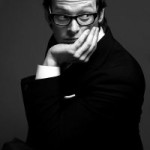 J.C. is a painter in Chicago. He also founded and hosts The Salon Series to bring audiences and creatives together over dinner for an evening of discussion. He prefers Mexican lagers, Gibson guitars and the window seat. More about his art and work can be found at www.jcsteinbrunner.com.
J.C. is a painter in Chicago. He also founded and hosts The Salon Series to bring audiences and creatives together over dinner for an evening of discussion. He prefers Mexican lagers, Gibson guitars and the window seat. More about his art and work can be found at www.jcsteinbrunner.com.
